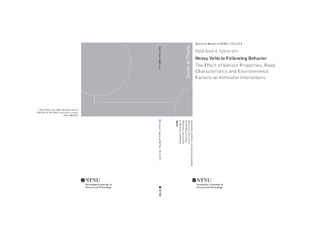| dc.contributor.advisor | Ryeng, Eirin Olaussen | |
| dc.contributor.advisor | Levin, Tomas | |
| dc.contributor.author | Hjelkrem, Odd André | |
| dc.date.accessioned | 2017-02-13T09:16:54Z | |
| dc.date.available | 2017-02-13T09:16:54Z | |
| dc.date.issued | 2016 | |
| dc.identifier.isbn | 978-82-326-2087-6 | |
| dc.identifier.issn | 1503-8181 | |
| dc.identifier.uri | http://hdl.handle.net/11250/2430367 | |
| dc.description.abstract | This thesis describes a series of studies made in the field of modelling heavy vehicle behavior. The main goal of the thesis was to investigate how car-following behavior of heavy vehicles differs from that of cars, how external factors affect this behavior, and how to incorporate this knowledge into traditional car-following models.
In a discipline where heavy vehicles have been neglected in favor of cars, an increased effort in research is needed to properly include heterogeneous traffic streams. However, any introduced complexity in the models should not increase the calibration demands. A large share of practitioners today spend too little time and effort on calibration, and increased calibration demands might increase this share.
The main focus of the thesis is describing heavy vehicle behavior. Through three research papers and one paper describing a data set, several aspects of heavy vehicle following behavior are investigated.
Previous work have shown that vehicle type of both leader and follower are important. Findings in the first paper indicate that only the follower vehicle type matters. A relationship between vehicle weight and time gap was found. It is also shown that both the threshold value for car-following behavior, and the desired time gap is different for cars and heavy vehicles.
The behavior of vehicles differ from location to location, depending on properties of the road and surroundings. It is shown that whether a heavy vehicle is in a rural or urban environment in combination with either congested or free flow, will affect the behavior. For cars, the most important factor was the number of lanes.
Weather also affects driver behavior. By measuring the speed and time gap in different weather and road surface situations, it is apparent that a snow covered road will reduce the speed and increase the time gap for both heavy vehicles and cars. Precipitation has a large effect on the following behavior of cars, but does not seem to have an impact on the behavior of heavy vehicles.
These empirical studies required several data sets about vehicle behavior to be collected. The data used in the first paper was collected from a Weigh-In-Motion detector, and included variables such as time gap, speed, vehicle weight, vehicle length, axle weight, and number of axles. About 670 000 time gaps were collected from a rural two-lane road for the study. The data set used in the second paper consisted of about 21 million observations from 16 detectors at different places in Norway. They were carefully selected for studying the impact of road characteristics. For the third paper, about 70 000 joint observations from a Weigh-In-Motion detector and a weather station were collected.
In the last research paper, Gipps’ car-following model was modified to have one common parameter set for all vehicle types, instead of one parameter set for each vehicle type. This was done by introducing a new parameter γ, a double exponential function of the gross vehicle weight. It was incorporated into Gipps’ model by multiplying it with the deceleration parameters of the leader and follower vehicle. The results showed that the measured time gap distributions had a slightly better fit to measured data in the field, despite less parameters to calibrate. | nb_NO |
| dc.language.iso | eng | nb_NO |
| dc.publisher | NTNU | nb_NO |
| dc.relation.ispartofseries | Doctoral theses at NTNU;2016:371 | |
| dc.relation.haspart | Paper 1: Hjelkrem, Odd Andre. Vehicle Type Characteristics During Car-Following Behavior | nb_NO |
| dc.relation.haspart | Paper 2: Hjelkrem, Odd Andre. Determining Influential Factors on the Threshold of Car-Following Behavior. TRB Annual Meeting | nb_NO |
| dc.relation.haspart | Paper 3a: Hjelkrem, Odd Andre; Ryeng, Eirin Olaussen. Chosen risk level during car-following in adverse weather conditions. Accident Analysis and Prevention 2016 ;Volum 95. s. 227-235
http://dx.doi.org/10.1016/j.aap.2016.07.006
The article in is reprinted with kind permission from Elsevier, sciencedirect.com | nb_NO |
| dc.relation.haspart | Paper 3b Hjelkrem, Odd Andre; Ryeng, Eirin Olaussen. Driver behaviour data linked with vehicle, weather, road surface, and daylight data. Data in Brief 2017 (10) s. 511-514
http://dx.doi.org/10.1016/j.dib.2016.12.036
Attribution 4.0 International (CC BY 4.0) | nb_NO |
| dc.relation.haspart | Paper 4: Hjelkrem, Odd Andre; Nerem, Sebastian. A transition from car-following to vehicle-following model. ITS World Congress 2015 | nb_NO |
| dc.title | Heavy Vehicle Following Behavior: The Effect of Vehicle Properties, Road Characteristics and Environmental Factors on Vehicular Interactions | nb_NO |
| dc.type | Doctoral thesis | nb_NO |
| dc.subject.nsi | VDP::Technology: 500::Building technology: 530::Building, construction and transport technology: 532 | nb_NO |
